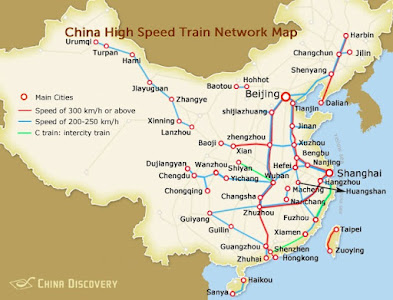On September 23, 2018, Hong Kong celebrated the opening of its high speed railway that has been described by government officials as the most beneficial infrastructure project for Hong Kong.1 The $11 billion dollar project indeed provides an alternative mode of travel to major cities in the Chinese Mainland, and according to the government's prediction is expected to hit a daily passenger volume of 80,000 (which was recently downward adjusted). The question, however, is whether it really justifies the huge construction cost and the subsequent expensive maintenance cost.
Network science, a rapidly growing discipline in physics and mathematics, may shed light on the pros and cons of Hong Kong's high speed railway as a means for connecting with the rest of China. A railway system is a network, which is characterized by a set of so-called nodes connected by links. For a railway network, a station is a node, and its importance may be measured by a few parameters, among which the "degree" of a node is often used to assess its connectivity. In non-technical terms, the "degree" of a station is just the number of other stations it connects immediately with. A high-degree station is what we normally refer to as a hub, like Shinjuku in Tokyo, King's Cross St Pancras in London, or Wuhan in China. Obviously, a hub will always attract a large volume of traffic as it radiates and connects to multiple nodes. In a railway network, the majority of nodes has a degree of two, connecting only two neighboring nodes. A few, however, has a high degree.
According to the latest railway map2,
Degree of Guangzhou = 7 (double links counted as 2)
Degree of Shenzhen = 5
Degree of Hong Kong = ?
Hong Kong is a one-degree node connecting permanently with an intermediate Futian station which then connects to Shenzhen North station, and that's it. Theoretically, the topological efficiency (node's) is also inherently low as it is located on one single route and right at its terminal. Other network attributes will also consistently rate Hong Kong's station as a less important node, e.g., the so-called betweenness centrality that reflects a node's ability of carrying passengers through it from various possible itineraries.
Hong Kong as a terminal station in the high-speed rail system is an inherently unimportant node. The high-speed railway is expected to play a very limited role as a means of transportation. Simply put, it connects only to Shenzhen, through which to other nodes serially (along one-dimensional lines). Under the current topological constraints (i.e., HKSAR being a boundary point, without through traffic), Hong Kong's high-speed rail has no room for further development. A literal dead-end so to speak!
September 26, 2018






No comments:
Post a Comment
Note: Only a member of this blog may post a comment.